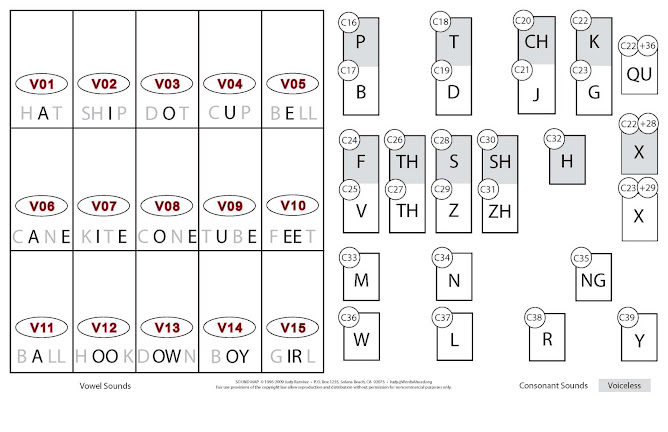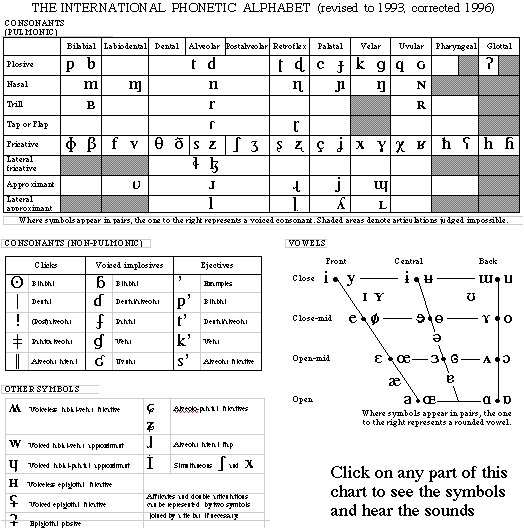By way of introduction, before commenting on the above textbook's information, let's analyze a sample message:
1) When whole words are typed onto the page, we will see a message. Here is an example:
The English language is composed of two types of articulated sound-units – Vowels and Consonants.
2) When whole words are parsed into phonetic categories, observe the message in an undulating flow of Vc code, down-up, up-down:
V = Vowel Sounds
c = Consonant Sounds
cV Vc ccVc cVc ccVc Vc cVc cVcc Vc cV cVcc Vc Vc cV ccV cV cVc cVccc cV Vcc Vcc cVc cV cVccc.
3) When VOWEL sound-units are given more detailed number-codes, V01 through V15
and if CONSONANT sound-units are given number-codes, C16 through C39, an undifferentiated string of sounds appear:
[C27] [V04] [V02] [C35] [C23] [C37] [V02] [C30] [C37] [V01] [C35] [C23] [V09] [V02] [C21] [V02] [C29] [C22] [V04] [C33] [C16] [V08] [C29] [C19]
[V04] [C25] [C18] [V09] [C18] [V07] [C16] [C28] [V04] [C25] [V11] [C38] [C18] [V02]
[C22] [C39] [V09] [C37] [V06] [C18] [V05] [C19] [C28] [V13] [C34] [C34]
[C29] [C25] [V13] [V05] [C37] [C29] [V01] [C34] [C19] [C22] [V03]
[C34] [C28] [V04] [C34] [V04] [C34][C18] [C28]
4) After above sound-units are heard and said, then "spell-out" those units using explicit {.Sound+Spellings.}. Understand how language works.
Speech sounds can be heard, said, spelled then read (pronounced red).
{.C27/th.}{.V04/e.}
the THE
{.V02/e.}{.C35/n.}
{.C23+37/gl.}{.V02/i.}{.C30/sh.}
En • glish
English ENGLISH
{.C37/l.}{.V01/a.}{.C35/n.}
{.C23+36/gu.}{.V02/a_e.}{.C21/g.}
lan • guage
language LANGUAGE
{.V02/i.}{.C29/s.}
is IS
{.C22/c.}{.V04/o.}{.C33/m.}
{.C16/p.}{.V08/o_e.}{.C29/s.}
compose COMPOSE
compose < compose(d)
{.C22/c.}{.V04/o.}{.C33/m.}
{.C16/p.}{.V08/o_e.}{.C29/s.}{.C19/d.}
com • posed
composed COMPOSED
{.V04/o.}{.C25/f.}
of OF
{.C18/tw.}{.V09/o.}
two TWO
{.C18/t.}{.V07/y_e.}{.C16/p.}
type TYPE
{.C18/t.}{.V07/y_e.}{.C16/p.}{.C28/s.}
types TYPES
{.V04/o}{.C25/f.}
of OF
{.V11/a.}{.C38/r.}
{.C18/t.}{.V02/i.}
{.C22/c.}{.C39+V09/u.}
{.C37/l.}{.V06/a_e}{.C18/t.}
articulate ARTICULATE
articulate <
{.V11/a.}{.C38/r.}
{.C18/t.}{.V02/i.}
{.C22/c.}{.C39+V09/u.}
{.C37/l.}{.V06/a}
{.C18/t.}{.V05/e.}{.C19/d.}
ar • ti • cu • la • ted
articulated ARTICULATED
{.C28/s.}{.V13/ou.}{.C34+19/nd.}
sound SOUND
{.C28/s.}{.V13/ou.}{.C34+19/nd.}{.C29/s.}
sounds SOUNDS
{.C25/v.}{.V13/ow/.}
{.V05/e.}.}{.C37/l.}
vowel VOWEL
{.C25/v.}{.V13/ow/.}
{.V05/e.}.}{.C37/l.}{.C29/s.}
vowelS VOWELS
{.V01/a.}{.C34/n.}{.C19/d.}
and AND
{.C22/c.}{.V03/o.}{.C34/n/.}
{.C28/s.}{.V04/o.}
{.C34/n.}{.V04/a.}{.C34/n.}{.C18/t.}
consonant CONSONANT
{.C22/c.}{.V03/o.}{.C34/n/.}
{.C28/s.}{.V04/o.}
{.C34/n.}{.V04/a.}{.C34/n.}{.C18/t.}{.C28/s.}
consonants CONSONANTS
Therefore, WordsAhead alleges that one's ability to precisely pronounce and explicitly sound-spell (ENCODE) will empower the learner's ability to easily decipher printed text (DECODE).
WA's mission is to help learners master the smallest sound-units and never cause confusion with letter-sounding names like "Short-Aa" and "Bb-Sound" and "Hard-Cc" and any letter-sounds.
__________________________________________
An Introduction to Language
by Fromkin, Rodman, Hamis, 8th Edition
2009 – 8th Edition, page 20
2019 – 11th Edition, page ?
Sign Language
Authors claim that signing systems (including American Sign Language) are "equivalent to the sound system of spoken language" referring to 1) fingerspelling letters A-Z and 2) gestures representing whole words or even larger concepts. WA claim that sign languages will only resemble spoken languages in all major aspects if sound-parsing is considered unimportant. All children – especially deaf children – need a SOUND FOUNDATION on which to base other language structures.
Note also that other popular communication systems are also flawed for the same reason. Morse Code, International Marine Signal Flags, and NATO Phonetic Alphabet ignore up to
40% of English speech sounds simply because they are based on ABCs. Read more at my blog,
"Systemic Error."
To reach its conclusions, WordsAhead adheres to two simple equations:
E = C + V English equals Consonant Sounds plus Vowel Sounds
E – C = V Subtract Consonant Sound-Spellings for Vowel {.Sound+Spellings.}
2009 8th Edition, page 239
2019 – 11th Edition, page ?
Vowel Sounds
"Classification of American English Vowels" (also printed inside the front cover) fails to provide several individual vowel sound-units:
{.V07/i_e.}
{.V13/ow.}
{.V14/oy.}
{.V15/ir.}{.V15/or.}{.V15/ur.}{.V15/er.} etc.
2009 8th Edition, page 225, 247
2019 – 11th Edition, page ?
Letter /r/
"A Phonetic Alphabet for English Pronunciation" (also printed inside the front cover) fails to provide the very important [V15]. An explanation of "syllabic r" is on Page 242, but that unit never finds its way into the text's Vowel Sound lists.
WordsAhead identifies two English speech sounds using Letter /r/:
Vowel Sound [V15]
Consonant Sound [C38]
Both sound-units occur in the first syllable of the word rural:
{.C39/r.}{.V15/ur.} • {.V04/a.}{.C37/l.}
Contrast the word grill where Letter Rr is part of a consonant blend.
{.C23+38/gr.}{.V02/i.}{.C37/ll.}
Experts dispute Letter Rr in girl.
Question: Is Letter Rr a consonant that controls a vowel?
This thinking employs ABC Logic, wherein Letter Rr is a consonant and the vowel is Letter Ii.
The textbook teaches that /r/ "controls" or "colors" letter /i/ in the [cVcc] pattern:
{.C23/g.}{.V04/i.}{.C38/r.}{.C37/l.}
MIND-CHANGER:
WordsAhead teaches 29 unique {.Sound+Spellings.} for [V15].
{.V15/ir.} girl first circle
{.V15/ire.} New Hampshire
{.V15/ir_e.} dirge
{.V15/irr.} stirrup squirrel
{.V15/iar.} plagiarism
{.V15/or.} work world thorough
{.V15/or_e.} worse
{.V15/oar.} cupboard
{.V15/orr.} corral worry
{.V15/orrh.} hemorrhagic logorrhea
{.V15/our.} courage courtesy journal journey
{.V15/our_e.} scourge
{.V15/oeu_re.} hors d'oeuvre
{.V15/ur.} hurt turn purpose
{.V15/ur_e.} purge surge nurse
{.V15/ure.} sure picture failure lecture
{.V15/urr.} purr burrow furrow hurry
{.V15/uerr.} guerrilla
{.V15/ear.} earth early pearl heard learn
{.V15/ear_e.} rehearse
{.V15/er.} term germ her person
{.V15/er_e.} verse merge nerve serve swerve
{.V15/ere.} were
{.V15/err.} preferred
{.V15/eur.} amateur pleurisy neurologist
{.V15/ar.} altar dollar solar cedar molar lunar
{.V15/yr.} syrup syringe myrtle
{.V15/yrrh.} myrrh
{.V15/ro.} iron
{.C39+V15/ur.} fury
{.C39+V15/ure.} pure
2009 8th Edition, page 297
2019 – 11th Edition, page ?
Typographical Conventions
WordsAhead is sound-based. Sounds come first, then spellings.
Sound-units are number-coded V01 through C39 on MAPS:
Simple typing indicates MAP unit names: V01, V02, V03... C37, C38, C39
[Brackets] indicate precise articulations: [V01] [C39]
{.Sound+Spellings.} contain both MAP unit code plus relevant unit letter-spelling:
{.V01/a.} apple
{.C39/y.} yum!
Textbooks are traditionally alphabet-based. Letters come first, then pronunciations.
Slashes / / indicate phonemes.
2009 8th Edition, page 225 – Basic Sound Units
2019 – 11th Edition, page 207 (helpful additions)
Phonetic Symbol/English Spelling Correspondences [Table 5.6]
Sound-units are translated for WordsAhead Heard Said Spelled Read.
Discover even more {.Sound+Spellings.} at flip.com/hssr
VOWELS
{.V01/a.} æ bat pan act
{.V01/a_e.} comrade
{.V01/au.} laugh
{.V02/i.} ɪ bit consist injury bin
{.V02/o.} women
{.V02/ui.} build
{.V03/o.} ɒ pot bomb cot hospital melodic
{.V03/ho.} honor
{.V04/u.} ʌ butt cut suppose
{.V04/e.} the
{.V04/a.} sofa alone
{.V04/o.} oven among cover symphony melody
{.V04/oe.} does
{.V04/oo.} flood
{.V04/ou.} tough
{.V05/e.} ɛ bet serenity
{.V05/ai.} said
{.V05/ay.} says
{.V05/ea.} dead
{.V05/ue.} guest
{.V06/a_e.} gate
{.V06/ai.} e bait
{.V06/au_e.} gauge
{.V06/ay.} ray
{.V06/ea.} great
{.V06/ei.} rein
{.V06/eig.} feign
{.V06/eigh.} eight
{.V06/ey.} greyhound
{.V07/i_e.} aj bite
{.V07/ie.} die
{.V07/i.} island choir
{.V07/ig.} sign
{.V07/igh.} sight
{.V07/ui_e.} guide
{.V07/uy.} buy
{.V07/eigh.} height
{.V07/ai.} aisle
{.V07/y.} by
{.V07/ye.} dye
{.V08/o_e.} bore
{.V08/oe.} toe
{.V08/o.} go
{.V08/oa.} o boat coat
{.V08/ough.} though
{.V08/ow.} own grow
{.V08/eau.} beau
{.V08/ew.} sew
{.V09/u_e.} lute
{.V09/ue.} true
{.V09/ui.} suit
{.V09/o.} to two who
{.V09/o_e.} move
{.V09/oo.} u boot too
{.V09/ou.} Lou
{.V09/ough.} through
{.V09/ew.} sewer
{.C39+V09/u_e.} use (wrongly listed under [C39]
{.C39+V09/eu.} feud (wrongly listed under [C39])
{.V10/ee.} i beet
{.V10/e.} be
{.V10/e_e.} serene
{.V10/ea.} beat
{.V10/ei_e.} receive
{.V10/eigh.} Raleigh
{.V10/eo.} people
{.V10/ey.} key
{.V10/ae.} Caesar
{.V10/i_e.} Vaseline
{.V10/ie_e.} believe
{.V10/oe.} amoeba
{.V11/a.} a bar ball stalk father palm
{.V11/au.} auto
{.V11/augh.} caught
{.V11/aw.} saw
{.V11/awe.} awe
{.V11/e.} sergeant
{.V12/oo.} ʊ foot
{.V12/u.} put butcher
{.V12/ou.} could
{.V13/ou.} aw bout doubt
{.V13/ow.} brown coward
{.V13/au.} sauerkraut
{.V14/oy.} ɔj boy
{.V14/oi.} oil
{.V14/eu.} Reuters
{.V15/ir.} bird (wrongly listed under [V04])
{.V15/er.} verb (wrongly lited under [V04]; singer (wrongly listed under [C38])
[C39+V15]
CONSONANTS
{.C16/p.} pill spit tip Lapp pit prick plaque appear
{.C17/b.} bill bit tab brat bubble
{.C18/t.} till stick pit write/writer tick intend
{.C19/tt.} attack bottle button glottal latter
{.C18/ed.} kissed
{.C19/pt.} pherodactyle
{.C19/d.} dill Dick cad drip loved ride/rider
{.C19/dd.} ladder
{.C20/ch.} tʃ chill rich choke discharge
{.C20/tch.} match Tchaikovsky
{.C20/t.} righteous
{.C21/j.} dʒ Jill judge
{.C21/d.} residual
{.C21/dg.} judge midget
{.C21/g.} George magistrate
{.C22/k.} kill skin elk kin
{.C22/ck.} stick
{.C22/c.} scat curl critic close
{.C22/qu.} critique
{.C22/ch.} charisma mechanic
[C22+28]
{.C22+36/qu.} queen
{.C23/g.} gill girl burg longer
{.C23/gh.} Pittsburgh
[C23+29]
{.C24/f.} feel fat flat reef
{.C24/ff.} coffee
{.C24/ph.} philosophy phlogiston
{.C24/gh.} cough
{.C25/v.} veal vat dove gravel
{.C26/th.} θ thigh through wrath ether
{.C26/tth.} Matthew
{.C27/th.} ð thy their weather lathe either
{.C28/s.} seal sip skip pats
{.C28/ss.} pass
{.C28/c.} democracy deceive
{.C18/sc.} descent
{.C18/st.} fasten
{.C28/ps.} psychology
{.C29/z.} zeal zip razor lazy maize
{.C29/zz.} jazz
{.C29/s.} pads kisses design
{.C29/ss.} scissors
{.C19/x.} Xerox
{.C30/sh.} ʃ shill shoe mush fish
{.C30/s.} sure
{.C30/ss.} mission
{.C30/t.} nation
{.C30/c.} glacial
{.C31/s.} ʒ measure vision casual
{.C31/z.} azure
{.C31/g.} genre rouge
{.C32/h.} heal hat rehash
{.C32/wh.} who whole
{.C33/m.} mill mitt tam smack
{.C33/mm.} Emmy
{.C33/mb.} comb
{.C33/mn.} Autumn
{.C34/n.} nil nick kin snow
{.C34/mn.} mnemonic
{.C34/gn.} gnome
{.C34/pn.} pneumatic
{.C34/kn.} know
{.C35/ng.} ŋ ring sing
{.C35/n.} think finger
{.C36/w.} witch witch swim
{.C32+C36/wh.} which where whale
{.C37/l.} leaf feel
{.C37/ll.} call
{.V12+C37/-le.} single
{.C38/r.} reef fear Paris
{.C39/y.} j you yes
2009 8th Edition, page 223
2019 – 11th Edition, page ?
[V10] Spellings
Translated:
{.V10/e.} he
{.V10/ie_e.} believe
{.V10/ae.} Caesar
{.V10/ee.} see
{.V10/eo.} people
{.V10/ei_e.} seize
{.V10/ea.} seas
{.V10/y.} silly
{.V10/oe.} amoeba
{.V10/ey.} key
{.V10/i_e.} machine
WordsAhead's SOUND MAP offers a more durable, competitive advantage for everyday usage than any International Phonetic Alphabet (IPA) Chart. Both charts are posted at the end of this blog.
2009 8th Edition, page 247
2019 – 11th Edition, page ?
Vowel Spellings
{.V01/a_e.} comrade
[V02]
{.V03/o.} cot
{.V03/ho.} honor
[V04]
{.V05/ay.} says
{.V06/a_e.} gate
{.V06/eigh.} eight
{.V06/au_e.} gauge
{.V06/eig.} reign
{.V07/i_e.} bite
{.V07/ai_e.} aisle
{.V07/i.} liar
{.V07/eigh.} height
{.V08/o_e.} core
{.V09/u_e.} lute
{.V09/o.} two
{.V09/o_e.} move
{.V10/ei_e.} receive
{.V10/ie_e.} believe
{.V10/i_e.} Vaseline
{.V10/e_e.} serene
{.V11/a.} walk, palm
{.V11/awe.} awe
[V12]
[V13]
[V14]
{.V15/ir.} bird
{.V15/er.} verb
[C39+V15]
2009 8th Edition, page 370
2019 – 11th Edition, page ?
Lexical Access and Reaction Time (RT)
WordsAhead alleges that word-meanings are best taught within a meaningful context.
Thus, word study ahead-of-time can use an author's precise vocabulary and focus only on precise sound-parsing (pronunciation) and explicit {.Sound+Spellings.}.
Lessons become more meaningful when the learner is demystifying vocabulary-to-be-read.
WA suggests using both synthesis and analysis.



